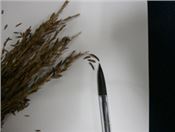|
Watch For Ergot Bodies In Grass Seedheads To Protect Livestock

WEST PLAINS, MO.
Conditions are right for the development of ergot, Claviceps purpurea, an airborne fungus that affects grass seedheads according to Sarah Kenyon, field specialist in agronomy with University of Missouri Extension.
“Wet, cool weather followed by high heat and humidity create ideal conditions for ergot growth. Farmers should begin scouting grass seedheads for this disease,” said Kenyon.
This fungal infection creates hard ergot bodies in the seed of grasses. The ergot bodies look like mouse droppings and are easily visible in the seedhead of cereal grains such as barley, oats, wheat, triticale, and rye, as well as many pasture grasses such as timothy, perennial ryegrass, orchardgrass, and tall fescue.
“Farmers should inspect pastures and hay for the presence of ergot bodies. Begin by inspecting the seedheads, if the pasture or hay does not contain seedheads there is no concern,” said Kenyon.
If seedheads are present look for ergot bodies (look like mouse droppings). If the pasture or hay contains ergot bodies, Kenyon says to be be cautious about feeding to livestock.
Ergot produces alkaloid compounds that are toxic to livestock and humans. The toxins constrict blood vessels, increasing respiration rates, raise core body temperatures, and limit blood supply to the extremities.
When livestock consume ergot they appeared to suffer from extreme heat stress. Livestock may seek relief in shade or stand in water. Other symptoms might include rapid breathing, sloughing of the tail switches and tips of ears, abortion, and decreased milk production. Livestock deaths may also result when large quantities are consumed.
Ergotism can be confused with fescue foot or fescue toxicosis because the symptoms are similar. However, ergot bodies (the ones that look like mouse droppings) have a thousand times more toxic alkaloids than those of fescue toxicosis.
“Because the toxin concentration is so much more, the animal symptoms appear quicker and are much more pronounced,” said Kenyon.
If ergot is observed in seedheads, producers should immediately move livestock from infected fields.
“Producers may also consider feeding other sources of feed to dilute the amount of ergot that is consumed. Hay containing ergot bodies can be destroyed or diluted with other feeds,” said Kenyon. ∆
|
|